The StyHarp for Matthew Herbert
A few months ago I was very lucky to meet musician/producer extraordinaire Matthew Herbert in person and learn about his exciting One Pig project. For this album Matthew recorded a single pig’s life “from birth to plate” and constructed an album out of the resultant sounds.
The Independent recently published an article about the album, read it here to learn all about the concept and motivation behind it all.
I’m extremely excited to now be a part of the live show for this album. Over the next few months I’ll be touring with Matthew as part of a five-piece band, playing a brand new controller/instrument built especially for the show – the StyHarp!
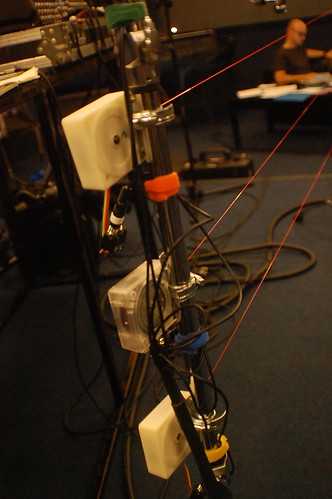
As the name suggests, the StyHarp is designed to mimic a pig sty, and is used in the show to trigger, control, and effect sounds in real time by pulling, plucking, and twisting the strings. It’s a very physical thing to play, which is part of the fun. I don’t have any great video footage of it in action, so you’ll have to make do with this hilarious video of me jamming with the band during rehearsals:
Our first show is this Friday September 2nd in London, at the Royal Opera House as part of the Deloitte Ignite Festival. As of this writing there are about 30 tickets remaining, so if you’d like to come you should book quickly! Otherwise we’ll be playing shows in the following weeks and months in Bolzano Italy, Tokyo, Eindhoven, Brussels, possibly Germany and Poland, and maybe more. I will post when I get more details, of course.
If you’re interested in the background and building of the StyHarp, keep on reading! Some technical details ahead…
When Matthew and I first started thinking about what we wanted to make for his show, we were certain that we wanted something physical, something with resistance and response, something that looked strange, perhaps even frightening, and evoked the themes present in the One Pig album. We wanted to be able to have direct control over sound, but also wanted something with a life of its own. The musicality and the theatrics had to be on equal footing. All of these things led me to want to make something with strings, something big and something that would take effort to play.
The main component of the StyHarp is the string sensors, which are ripped from Gametrak controllers. These gadgets are a sort of proto-Kinect, designed for PCs and game consoles. They were marketed as 3D motion trackers, and packaged mostly with golf games (with comical miniature golf clubs) and sold only in the UK from 2000-2006 or so. To use a Gametrak the player wears a pair of gloves which are connected to a base station with some wire (which looks suspiciously like orange fishing line). Inside the base station these two lines each go into a spool, which is connected by a few gears to a standard potentiometer. The potentiometer thus turns as the wire is pulled in and out. The wire is also fed through an X-Y joystick-style potentiometer. The result is that the distance and location relative to the base station can be tracked with startling accuracy, all using technology that has been around for over a hundred years. Pretty great, huh? It’s a wonder no one thought of designing a controller like this for the Atari or the Binatone TV Master.
Many thanks to Jung In Jung and Martin Parker for introducing me to the Gametrak and for helping me track down a few extra for this project!

So the design we settled on for the StyHarp called for 12 Gametrak strings (four per side, three sides), thus six Gametraks. Each Gametrak has a USB output, but it turns out that only the XBox and PC versions of the Gametrak can be used as a HI Device (and the XBox version requires a little hacking even to do that), so it quickly became apparent that I would not be able to just plug them all into my computer. However, Jon (aka Lucky Frame partner in crime) suggested I tap into the outputs directly from the potentiometers, and plug them into an Arduino, thus bypassing the Gametrak’s USB circuitry altogether. That worked great! However….each Gametrak has six parameters (x, y, and distance for each), which means I needed 36 analog inputs, and the Arduino only supports 6. Even the Arduino Mega only supports 16! So I decided to use the Arduino Mux Shield from Mayhew Labs. This lets me have up to 48 analog inputs, which are multiplexed through the digital pins in some way that I don’t understand.
During the early stages of development (i.e., three weeks ago) I was planning on using the Gametraks in a fairly un-hacked form. This was because the models that I had bought did not seem all that conducive to hacking – the gearing was more or less separated from the wire spools, and it seemed like a headache. Some people have done it (including this guy, who used it to build a Gametrak-based Ondes Martenot), but it didn’t seem worth it to me. However, I ended up finding a few later model Gametraks, apparently released in 2006, which use a slightly different construction which lends itself to hacking – in fact, the whole reel, gearing, and potentiometer setup is tightly packaged into individual and completely separate little boxes! It’s amazing. So I found a bunch of these and ripped them apart, and I had all the sensors I needed. I was even able to hack out the little connector wires that they use. If this interests you, be sure to find the ones that have rounded ends like this.
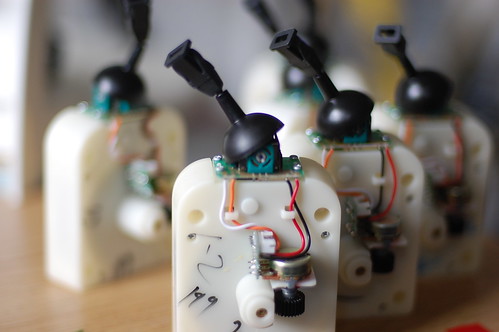
To connect everything to the Arduino I’m using 1/4″ stereo jack cables. This is partially because I had a loom kicking about my studio, but also because it is an affordable and robust connector, and venues are generally guaranteed to have a bunch of them just in case. I therefore attached two female connectors to each set of wires which connect to the Gametrak sensors, and I built a patchbay box for my Arduino.
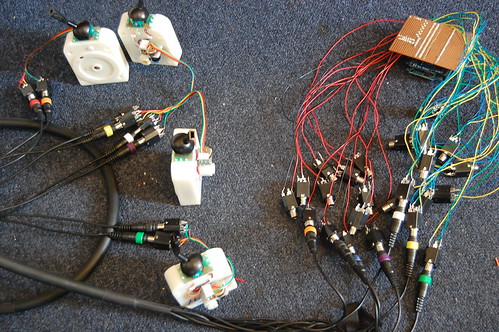
On the software end, the Arduino is communicating through USB using a serial data system built by Jon in Processing. This is much more robust than the software provided by Mayhew Labs, which kept on crashing because of the load of data coming through…Jon implemented a brilliant call-response system which eliminated all crashing. Go go Lucky Frame! So Jon’s utility is sending all the data via OSC into Max/MSP, where I’ve built a flexible patch for sending MIDI notes and controls to Ableton Live, where all of the sound processing and triggering is going on. The sounds are all original recordings from the One Pig album, and they are triggered by pulling or plucking the strings. Twisting and pulling the strings then control other effects like delays, filters, and so on.
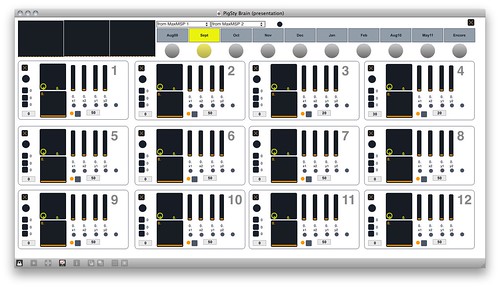
The Gametraks are all connected to stands using plumbing fixtures, and the strings are pulled out to connect across and create the fence. I’ll be inside the sty for much of the show, playing the strings, and I’ll be joined at one point by the rest of the band…but I won’t give away the ending.
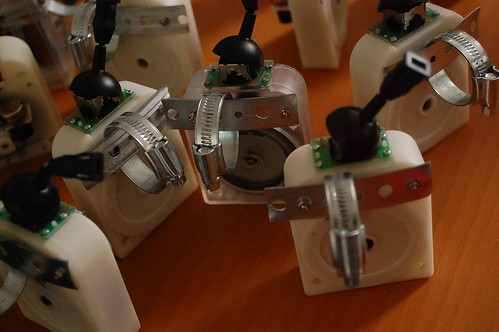
It’s loads of fun to play, and I’m really looking forward to the shows. Come by if you can, and as usual get in touch if you have any questions.
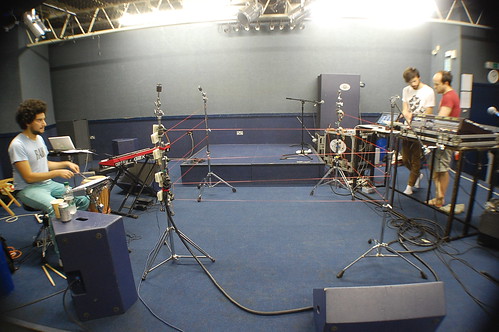
[…] the focal point of the stage, is Yann Seznec, a Franco-American living in Edinburgh who created the styharp. At intervals, he changed his white lab coat from plain to ones marked with SEP, OCT, NOV, DEC and […]
[…] band for Matthew Herbert‘s live show for the project One Pig. The show involves an electronic Pig Sty Harp created and played by Yann Seznec alongside Tom Skinner, Sam Beste, Matthew and myself. The shows […]
[…] The Amazing Rolo music, sound design, movies, and more Previous Post: The StyHarp for Matthew Herbert […]
[…] required is too delicate to travel much anyway: it includes pig bones, a drum made of pigskin and a StyHarp, a device created by the sound designer Yann Seznec that uses strings — not from a pig — to cue […]
[…] and company to do some more One Pig Live shows. I’ve spent the last few days tweaking the Sty Harp and I’m looking forward to the […]
magnificent concert tonite in the AB, brussels, belgium, it was really marvelous,
thx for the very good evening you brought to us, and the saucage was very teasty indeed!
Alex
I’m really glad you enjoyed the show and the sausage, Alex, thanks for coming! I think for us it was in many ways the best show of the tour so far. Great crowd, fantastic venue and sound. Cheers!
[…] can be found on Twitter @theamazingrollo. You can read a very detailed description of how he built the Sty Harp, from a design and development perspective, on his […]
[…] full description of how we built the instrument, soon dubbed the Sty Harp, you can head over to my Amazing Rolo blog. I basically ended up hacking a bunch of Gametrak controllers to use their wonderful innards, which […]
[…] StyHarp for Matthew Herbert http://www.theamazingrolo.net/2011/08/styharp/ Edinburgh-based sound artist Yann Seznec built an instrument mimicking a pigsty using Gametrak […]
nice work yann!!!
[…] Seznec is part raver, part boxer engaged in a hopeless fight for survival. As Seznec explains on his blog, the mechanism behind the sty-harp is the obsolete GameTrak controller for the XBox and PC. The […]